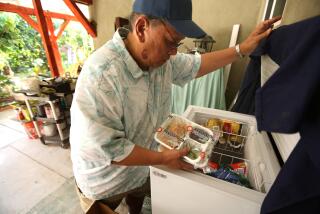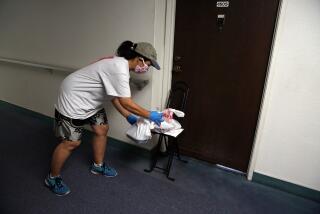At Home, the Safety Net Is Frayed
- Share via
“At Colonel Sanders they used to put the leftovers in the garbage bin. There used to be 10-15 people every night looking for food in the garbage, including myself--just looking for something to eat.” --Rufus Herold, former homeless senior, now on staff at St. Mary’s Center, Oakland
*
Rufus Herold is no economic expert, but he does know about hunger. He could write a book about his experiences while looking for something to eat. Today Herold helps other seniors find their way out of dehumanizing hunger, poverty and homelessness.
While Herold ladles out soup at the St. Mary’s Center, our government tells us that the economy is booming, with low unemployment, rising incomes and shrinking welfare rolls. But like many of the country’s poor, Herold knows the problem is bigger than his personal struggle. Facing hunger last year were an estimated 30 million Americans, of which 12 million were children. Some 63% of the elderly are at moderate or high nutritional risk.
Two years after the passage of the Orwellian sounding “Personal Responsibility and Work Opportunity Reconciliation Act,” better known as welfare reform, Herold wishes that policymakers--who never have known hunger--could get a closer look at the people waiting in food lines. Then maybe they would understand, and maybe they would change things.
By the first anniversary of the law in August 1997, there were 9.9 million people left on welfare, a drop of more than 2.2 million. This dramatic shrinkage conveys the impression that welfare reform has been a resounding success. While Clinton administration officials rush to take credit for the decline in welfare rolls, some acknowledge that they do not know what has happened to families who have lost assistance.
The welfare law hit hardest those who cannot afford enough food to feed themselves and their families. More than half of the $54 billion in welfare cuts over a period of six years will come from the food stamps that 25 million poor Americans depended on. More than 50% of the beneficiaries are children, and more than 80% of the benefits go to families with children. Another $3 billion has been cut from child nutrition programs, including child care and summer care programs. Food stamps for adults without dependents have been slashed to three months out of every three years, and an estimated 650,000 legal immigrants have been denied help.
Citizen-initiated food banks are intended to make up for some of the gaps in the safety net. Yet with welfare reform, they are being relied on as the safety net. The food stamp cuts average $4 billion per year while the total value of all food in the food banks in the country is just $1 billion a year. Second Harvest, the country’s largest chain of food banks, reported that it provided some food for almost 26 million people in 1997--nearly 10% of America’s population. Not all who needed food received it; an estimated 2.3 million hungry people were turned away because of lack of food. The U.S. Conference of Mayors surveyed 29 cities and found emergency requests up 16%. One in five requests could not be filled. Nine out of 10 cities expect demand to have risen again in 1998.
To compensate fully for the government cuts in food programs, each of the 350,000 churches in the U.S. would have to contribute an average $150,000 per year. Very few churches have total budgets that big. To make up for the shortfall, the nonprofit sector would have to distribute a total of 24.5 billion pounds of food over the next six years--four times more than the current distribution--and enough to fill 5 million National Guard trucks.
It’s going to be a grim Thanksgiving for millions this year. It’s also the 50th anniversary of the Universal Declaration of Human Rights, which committed our government to provide a standard of living adequate for the health and well-being of everyone. These commitments include the obligation to respect, protect, facilitate and fulfill the right to food, clothing, housing, medical care and necessary social services in the event of unemployment, sickness, disability or old age. A widely supported statement at the time, the promises of the declaration today seem outrageous to many in the age of “personal responsibility” and welfare reform. But when you look hard, what’s more outrageous? A broad and sturdy safety net for all members of our society? Or one out of four children hungry and poor in the richest country on Earth?
More to Read
Sign up for Essential California
The most important California stories and recommendations in your inbox every morning.
You may occasionally receive promotional content from the Los Angeles Times.










